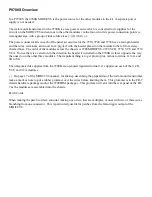
3
Tuning and Calibrating Automatically in the ESI/MS Mode
Testing the Operation of the MS Detector in the ESI/MS Mode
Thermo Electron Corporation
LTQ XL Getting Started
53
i.
In the Type group box, click the
Unimetrics
(or
Hamilton
)
option button to specify the proper syringe type.
ii. Click the
Volume
list box arrow to display the list of available
volumes, and then select
500
(or your syringe size) from the list
to set the proper syringe volume. Note that, if you are using a
Unimetrics syringe, the LTQ XL MS detector automatically sets
the syringe ID to its proper value of 3.260 mm.
d. If you are not using a Unimetrics (or Hamilton) syringe, set up the
syringe parameters as follows:
i.
In the Type group box, click the
Other
option button to make
active the syringe ID spin box.
ii. Type the inner diameter of your syringe in the Syringe ID spin
box.
e. Click
OK
to apply the syringe parameters, start the syringe pump,
and close the Syringe Pump dialog box.
3. On the File/Display toolbar, click the
Display Spectrum View
button
to ensure that the Spectrum view is displayed.
4. Monitor the data for the calibration solution, as follows:
a. In the Spectrum view of the Tune Plus window, observe the mass
spectra of the singly-charged ions of calibration solution. The ions
are as follows. See
.
• Caffeine:
m/z
195
• MRFA:
m/z
524
• Ultramark 1621:
m/z
1022, 1122, 1222, 1322, 1422, 1522, 1622,
1722, 1822
b. At the top of the Spectrum view, notice the values for the ionization
time (IT) and normalization level (NL). See
c. Click the
API Source
button to open the ESI Source dialog box.
(See the Spray Current readback shown in
.)
Note
Based on the LC flow rate of your experiment, you can
specify the value of each of the following tuning parameters on
the LTQ XL MS detector: sheath, Auxiliary, and Sweep gas
pressures, ESI needle (or “spray”) voltage, ion transfer capillary
temperature, and probe position. Automatic tuning sets the
values of the other parameters.
















































